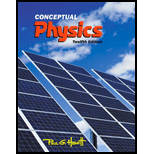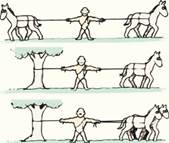
Conceptual Physics (12th Edition)
12th Edition
ISBN: 9780321909107
Author: Paul G. Hewitt
Publisher: PEARSON
expand_more
expand_more
format_list_bulleted
Concept explainers
Textbook Question
Chapter 5, Problem 80RCQ
The strong man can withstand the tension force exerted by the two horses pulling in opposite directions. How would the tension compare if only one horse pulled and the left rope were tied to a tree?
How would the tension compare if the two horses pulled in the same direction, with the left rope tied to the tree?

Expert Solution & Answer
Want to see the full answer?
Check out a sample textbook solution
Students have asked these similar questions
No chatgpt pls will upvote
No chatgpt pls will upvote
You are standing a distance x = 1.75 m away from this mirror. The object you are looking at is y = 0.29 m from the mirror. The angle of incidence is θ = 30°. What is the exact distance from you to the image?
Chapter 5 Solutions
Conceptual Physics (12th Edition)
Ch. 5 - When you push against a wall with your fingers,...Ch. 5 - A boxer can hit a heavy bag with great force. Why...Ch. 5 - How many forces are required for an interaction?Ch. 5 - Prob. 4RCQCh. 5 - Consider hitting a baseball with a bat. If we call...Ch. 5 - Prob. 6RCQCh. 5 - Prob. 7RCQCh. 5 - Prob. 8RCQCh. 5 - Prob. 9RCQCh. 5 - Earth pulls down on you with a gravitational force...
Ch. 5 - Prob. 11RCQCh. 5 - Prob. 12RCQCh. 5 - Prob. 13RCQCh. 5 - Prob. 14RCQCh. 5 - Prob. 15RCQCh. 5 - Prob. 16RCQCh. 5 - Prob. 17RCQCh. 5 - Prob. 18RCQCh. 5 - Prob. 19RCQCh. 5 - Prob. 20RCQCh. 5 - Prob. 21RCQCh. 5 - Prob. 22RCQCh. 5 - Prob. 23RCQCh. 5 - Prob. 24RCQCh. 5 - Prob. 25RCQCh. 5 - Prob. 26RCQCh. 5 - Prob. 27RCQCh. 5 - Prob. 28RCQCh. 5 - Prob. 29RCQCh. 5 - Prob. 30RCQCh. 5 - 31. A van exerts a force on trailers of different...Ch. 5 - a. The accelerations of the boxes
b. The...Ch. 5 - 33. Three identical pucks, A, B, and C, are...Ch. 5 - Prob. 34RCQCh. 5 - 35. The photo shows Steve Hewitt and daughter...Ch. 5 - Prob. 36RCQCh. 5 - Prob. 37RCQCh. 5 - Prob. 38RCQCh. 5 - Prob. 39RCQCh. 5 - Prob. 40RCQCh. 5 - Prob. 41RCQCh. 5 - Prob. 42RCQCh. 5 - Prob. 43RCQCh. 5 - Prob. 44RCQCh. 5 - Prob. 45RCQCh. 5 - Prob. 46RCQCh. 5 - Prob. 47RCQCh. 5 - Prob. 48RCQCh. 5 - Prob. 49RCQCh. 5 - Suppose that two carts, one twice as massive as...Ch. 5 - Prob. 51RCQCh. 5 - Prob. 52RCQCh. 5 - Prob. 53RCQCh. 5 - Prob. 54RCQCh. 5 - Prob. 55RCQCh. 5 - Prob. 56RCQCh. 5 - Prob. 57RCQCh. 5 - Prob. 58RCQCh. 5 - Prob. 59RCQCh. 5 - Prob. 60RCQCh. 5 - Prob. 61RCQCh. 5 - Prob. 62RCQCh. 5 - The same stone is being accelerated vertically...Ch. 5 - Prob. 64RCQCh. 5 - Prob. 65RCQCh. 5 - Here the stone is sliding down a friction-free...Ch. 5 - The stone is at rest, interacting with both the...Ch. 5 - Prob. 68RCQCh. 5 - Prob. 69RCQCh. 5 - Prob. 70RCQCh. 5 - Prob. 71RCQCh. 5 - Prob. 72RCQCh. 5 - Prob. 73RCQCh. 5 - Prob. 74RCQCh. 5 - Prob. 75RCQCh. 5 - Prob. 76RCQCh. 5 - Prob. 77RCQCh. 5 - Prob. 78RCQCh. 5 - Prob. 79RCQCh. 5 - The strong man can withstand the tension force...
Knowledge Booster
Learn more about
Need a deep-dive on the concept behind this application? Look no further. Learn more about this topic, physics and related others by exploring similar questions and additional content below.Similar questions
- For each of the actions depicted below, a magnet and/or metal loop moves with velocity v→ (v→ is constant and has the same magnitude in all parts). Determine whether a current is induced in the metal loop. If so, indicate the direction of the current in the loop, either clockwise or counterclockwise when seen from the right of the loop. The axis of the magnet is lined up with the center of the loop. For the action depicted in (Figure 5), indicate the direction of the induced current in the loop (clockwise, counterclockwise or zero, when seen from the right of the loop). I know that the current is clockwise, I just dont understand why. Please fully explain why it's clockwise, Thank youarrow_forwardA planar double pendulum consists of two point masses \[m_1 = 1.00~\mathrm{kg}, \qquad m_2 = 1.00~\mathrm{kg}\]connected by massless, rigid rods of lengths \[L_1 = 1.00~\mathrm{m}, \qquad L_2 = 1.20~\mathrm{m}.\]The upper rod is hinged to a fixed pivot; gravity acts vertically downward with\[g = 9.81~\mathrm{m\,s^{-2}}.\]Define the generalized coordinates \(\theta_1,\theta_2\) as the angles each rod makes with thedownward vertical (positive anticlockwise, measured in radians unless stated otherwise).At \(t=0\) the system is released from rest with \[\theta_1(0)=120^{\circ}, \qquad\theta_2(0)=-10^{\circ}, \qquad\dot{\theta}_1(0)=\dot{\theta}_2(0)=0 .\]Using the exact nonlinear equations of motion (no small-angle or planar-pendulumapproximations) and assuming the rods never stretch or slip, determine the angle\(\theta_2\) at the instant\[t = 10.0~\mathrm{s}.\]Give the result in degrees, in the interval \((-180^{\circ},180^{\circ}]\).arrow_forwardWhat are the expected readings of the ammeter and voltmeter for the circuit in the figure below? (R = 5.60 Ω, ΔV = 6.30 V) ammeter I =arrow_forward
- simple diagram to illustrate the setup for each law- coulombs law and biot savart lawarrow_forwardA circular coil with 100 turns and a radius of 0.05 m is placed in a magnetic field that changes at auniform rate from 0.2 T to 0.8 T in 0.1 seconds. The plane of the coil is perpendicular to the field.• Calculate the induced electric field in the coil.• Calculate the current density in the coil given its conductivity σ.arrow_forwardAn L-C circuit has an inductance of 0.410 H and a capacitance of 0.250 nF . During the current oscillations, the maximum current in the inductor is 1.80 A . What is the maximum energy Emax stored in the capacitor at any time during the current oscillations? How many times per second does the capacitor contain the amount of energy found in part A? Please show all steps.arrow_forward
- A long, straight wire carries a current of 10 A along what we’ll define to the be x-axis. A square loopin the x-y plane with side length 0.1 m is placed near the wire such that its closest side is parallel tothe wire and 0.05 m away.• Calculate the magnetic flux through the loop using Ampere’s law.arrow_forwardDescribe the motion of a charged particle entering a uniform magnetic field at an angle to the fieldlines. Include a diagram showing the velocity vector, magnetic field lines, and the path of the particle.arrow_forwardDiscuss the differences between the Biot-Savart law and Coulomb’s law in terms of their applicationsand the physical quantities they describe.arrow_forward
- Explain why Ampere’s law can be used to find the magnetic field inside a solenoid but not outside.arrow_forward3. An Atwood machine consists of two masses, mA and m B, which are connected by an inelastic cord of negligible mass that passes over a pulley. If the pulley has radius RO and moment of inertia I about its axle, determine the acceleration of the masses mA and m B, and compare to the situation where the moment of inertia of the pulley is ignored. Ignore friction at the axle O. Use angular momentum and torque in this solutionarrow_forwardA 0.850-m-long metal bar is pulled to the right at a steady 5.0 m/s perpendicular to a uniform, 0.650-T magnetic field. The bar rides on parallel metal rails connected through a 25-Ω, resistor (Figure 1), so the apparatus makes a complete circuit. Ignore the resistance of the bar and the rails. Please explain how to find the direction of the induced current.arrow_forward
arrow_back_ios
SEE MORE QUESTIONS
arrow_forward_ios
Recommended textbooks for you
 University Physics Volume 1PhysicsISBN:9781938168277Author:William Moebs, Samuel J. Ling, Jeff SannyPublisher:OpenStax - Rice University
University Physics Volume 1PhysicsISBN:9781938168277Author:William Moebs, Samuel J. Ling, Jeff SannyPublisher:OpenStax - Rice University Physics for Scientists and Engineers: Foundations...PhysicsISBN:9781133939146Author:Katz, Debora M.Publisher:Cengage Learning
Physics for Scientists and Engineers: Foundations...PhysicsISBN:9781133939146Author:Katz, Debora M.Publisher:Cengage Learning Glencoe Physics: Principles and Problems, Student...PhysicsISBN:9780078807213Author:Paul W. ZitzewitzPublisher:Glencoe/McGraw-Hill
Glencoe Physics: Principles and Problems, Student...PhysicsISBN:9780078807213Author:Paul W. ZitzewitzPublisher:Glencoe/McGraw-Hill Principles of Physics: A Calculus-Based TextPhysicsISBN:9781133104261Author:Raymond A. Serway, John W. JewettPublisher:Cengage Learning
Principles of Physics: A Calculus-Based TextPhysicsISBN:9781133104261Author:Raymond A. Serway, John W. JewettPublisher:Cengage Learning An Introduction to Physical SciencePhysicsISBN:9781305079137Author:James Shipman, Jerry D. Wilson, Charles A. Higgins, Omar TorresPublisher:Cengage Learning
An Introduction to Physical SciencePhysicsISBN:9781305079137Author:James Shipman, Jerry D. Wilson, Charles A. Higgins, Omar TorresPublisher:Cengage Learning College PhysicsPhysicsISBN:9781305952300Author:Raymond A. Serway, Chris VuillePublisher:Cengage Learning
College PhysicsPhysicsISBN:9781305952300Author:Raymond A. Serway, Chris VuillePublisher:Cengage Learning

University Physics Volume 1
Physics
ISBN:9781938168277
Author:William Moebs, Samuel J. Ling, Jeff Sanny
Publisher:OpenStax - Rice University

Physics for Scientists and Engineers: Foundations...
Physics
ISBN:9781133939146
Author:Katz, Debora M.
Publisher:Cengage Learning

Glencoe Physics: Principles and Problems, Student...
Physics
ISBN:9780078807213
Author:Paul W. Zitzewitz
Publisher:Glencoe/McGraw-Hill

Principles of Physics: A Calculus-Based Text
Physics
ISBN:9781133104261
Author:Raymond A. Serway, John W. Jewett
Publisher:Cengage Learning

An Introduction to Physical Science
Physics
ISBN:9781305079137
Author:James Shipman, Jerry D. Wilson, Charles A. Higgins, Omar Torres
Publisher:Cengage Learning

College Physics
Physics
ISBN:9781305952300
Author:Raymond A. Serway, Chris Vuille
Publisher:Cengage Learning
Newton's First Law of Motion: Mass and Inertia; Author: Professor Dave explains;https://www.youtube.com/watch?v=1XSyyjcEHo0;License: Standard YouTube License, CC-BY